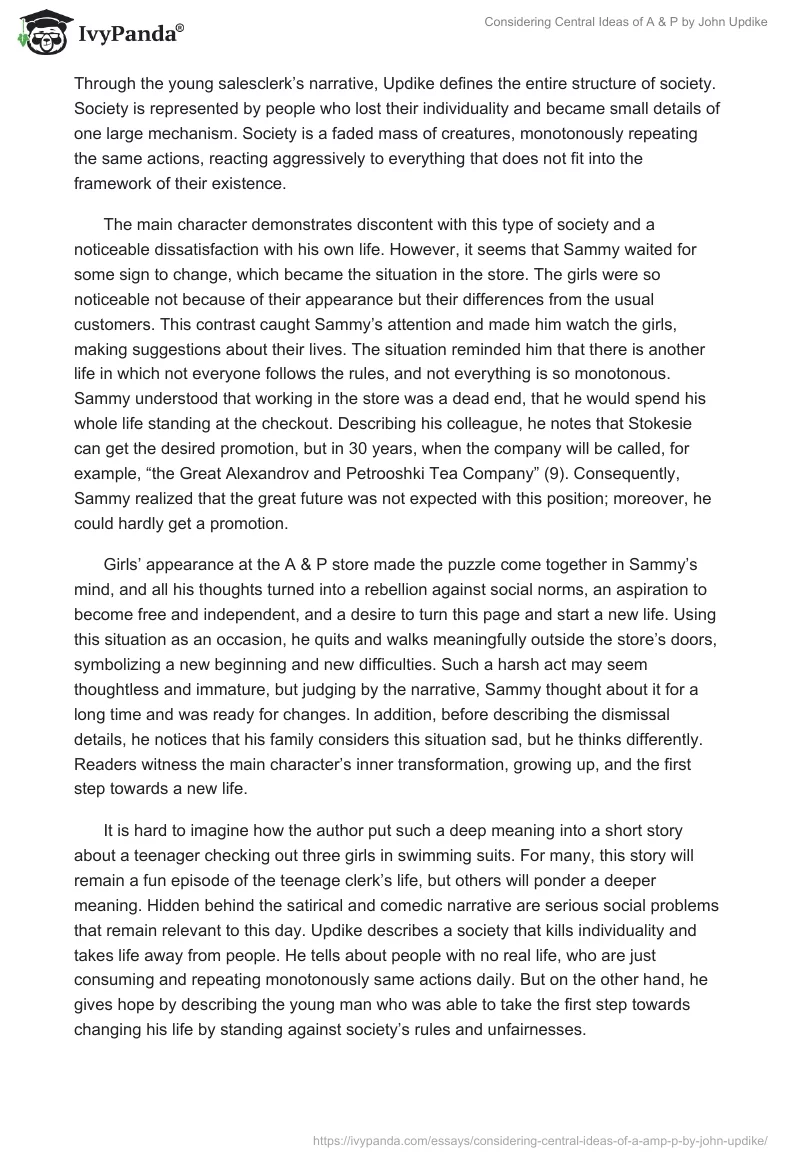Written by John Updike in 1961, A & P tackles a problem that is still relevant nowadays. Upon first reading, it may seem that the story is an unremarkable tale of a teenager Sammy, who fell for an attractive girl in a bathing suit. However, A & P has a much broader meaning, which the author puts into a few pages of text and a few minutes of the character’s life. Through the setting of a grocery shop, A & P reflects the society as a herd of consumers living identical days and being conservative to any changes. On the other hand, the work demonstrates the main character’s transformation caused by the contrasting situation, the rebellion against society, and the desire to live an adult and conscious life, despite the difficulties ahead.
Although the main character is a 19-year-old teenager, his judgments appear to be meaningful and critical. By working at the grocery store checkout, Sammy observed people’s behavior daily. People are portrayed as house-slaves whose life purpose is consumption. The protagonist calls the customers “the sheep” because they function as a herd, following one after another, repeating the same actions regularly. People are like robots whose lives are monotonous, and mistakes or changes are unexpected and unacceptable. An example is a female customer who made a scandal for Sammy, who “been watching cash registers forty years and probably never seen a mistake before” (1). As Sammy remarked, nothing could distract those people: even if someone would detonate a bomb in the store, customers “would by and large keep reaching and checking oatmeal off their lists” (5). Nonetheless, any nonobservance of the rules is condemned by this society. Noticing three young girls’ inappropriate appearance, customers turned around. As well as girls’ appearance, their movement “against the usual traffic” (5) also discouraged others.
However, the main character who personifies strict rules and protects order is manager Lengel. He is a typical manager that can be found in any company; moreover, Lengel reflects conservatism in society. Operating with the same phrases and company’s policy, he shames the girls and refuses to listen to their explanations. In this context, Lengel reflects the principles of society: everyone should be the same and follow the rules, and those who are different and have their own opinion should leave. Through the young salesclerk’s narrative, Updike defines the entire structure of society. Society is represented by people who lost their individuality and became small details of one large mechanism. Society is a faded mass of creatures, monotonously repeating the same actions, reacting aggressively to everything that does not fit into the framework of their existence.
The main character demonstrates discontent with this type of society and a noticeable dissatisfaction with his own life. However, it seems that Sammy waited for some sign to change, which became the situation in the store. The girls were so noticeable not because of their appearance but their differences from the usual customers. This contrast caught Sammy’s attention and made him watch the girls, making suggestions about their lives. The situation reminded him that there is another life in which not everyone follows the rules, and not everything is so monotonous. Sammy understood that working in the store was a dead end, that he would spend his whole life standing at the checkout. Describing his colleague, he notes that Stokesie can get the desired promotion, but in 30 years, when the company will be called, for example, “the Great Alexandrov and Petrooshki Tea Company” (9). Consequently, Sammy realized that the great future was not expected with this position; moreover, he could hardly get a promotion.
Girls’ appearance at the A & P store made the puzzle come together in Sammy’s mind, and all his thoughts turned into a rebellion against social norms, an aspiration to become free and independent, and a desire to turn this page and start a new life. Using this situation as an occasion, he quits and walks meaningfully outside the store’s doors, symbolizing a new beginning and new difficulties. Such a harsh act may seem thoughtless and immature, but judging by the narrative, Sammy thought about it for a long time and was ready for changes. In addition, before describing the dismissal details, he notices that his family considers this situation sad, but he thinks differently. Readers witness the main character’s inner transformation, growing up, and the first step towards a new life.
It is hard to imagine how the author put such a deep meaning into a short story about a teenager checking out three girls in swimming suits. For many, this story will remain a fun episode of the teenage clerk’s life, but others will ponder a deeper meaning. Hidden behind the satirical and comedic narrative are serious social problems that remain relevant to this day. Updike describes a society that kills individuality and takes life away from people. He tells about people with no real life, who are just consuming and repeating monotonously same actions daily. But on the other hand, he gives hope by describing the young man who was able to take the first step towards changing his life by standing against society’s rules and unfairnesses.
Works Cited
Updike, John. “A & P.” The Compact Bedford Introduction to Literature, edited by Michael Meyer and D. Quentin Miller, 12th ed., Bedford/St. Martin’s, 2020, pp. 140-144.


